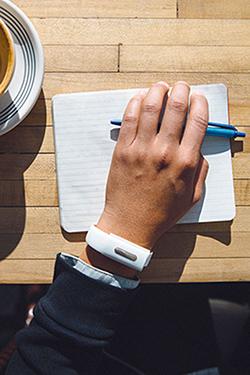May 29, 2015

From our fridges to our thermostats to our cars, the physical world is slowly becoming connected through the Internet of Things. Building a network of connected things promises to make our lives easier and more efficient by allowing our smart things to do most of the work for us. But if we are going to be creating a network that serves us, one of its most critical nodes will need to be ourselves. This is where wearable technology comes into play.
One of the major benefits of wearable technology is making ourselves connected, therefore putting us on the map of the Internet of Things. Sensors that are worn close to our body persistently throughout the day, combined with connectivity such as Bluetooth or WiFi, allow us to authenticate, personalize, and interact with our connected world.

Gesture-based wearables such as Thalmic Labs' Myo provide a means to interact with the connected things around us with the wave of a hand. The Myo armband uses muscle activity to understand gestures and motion to act as a remote control for the smart world. Thalmic Labs has shown Myo as a touch-free controller for presentations, video gaming, and even robotics.
But gesture is just one mode of interaction. Wearables that translate our movements, voice, and even our thoughts will be used to interact and engage with smart things in a more "human" and natural manner.
Wearables will also allow us to personalize our environments. IFTTT (if this then that), an Internet automation service, is an app for Android Wear and Apple Watch that turns a smartwatch into a powerful home automation tool. Users are able to control smart lighting systems like Philips Hue and connected thermostats like Nest with the push of a button.
MORE FROM DESIGN NEWS: 5 Challenges in Wearable Product Design You Can't Afford to Forget
Eventually, applications such as this will identify the user and automatically adjust the temperature, lighting, and other environmental qualities based on predefined preferences without the user having to do a thing.
To do this, however, our smart world needs to recognize us as unique individuals. Bionym's Nymi, a heartbeat authentication bracelet, is a great example of how wearables will play a role in identifying us to the connected world.
Nymi's Heart ID technology uses a user's unique heart signature (or ECG) as an identifier. Once identified, this information is used to authenticate the user on any supporting systems. Bionym currently demonstrates how the Nymi works in its first set of applications by allowing users to unlock their Android smartphones, PCs, or Macs without the need for passwords or pin numbers while wearing the band.
The company is also working with the Royal Bank of Canada (RBC) on a pilot program that will see its technology used as a secure payment system. It is also focusing on enterprise solutions, which would see the wristband be used to identify employees for security purposes and grant access to systems.
As more and more of our world become connected, the need to engage ourselves as part of it will also grow. Wearables may be considered nice-to-have for many consumers today, but they will eventually become a necessary tool for our way of living and working that is not too far in our future.
Tom Emrich writes about emerging technology including wearable tech, 3D printing, and the Internet of Things for many technology, lifestyle, and news publications. He is currently the Editor-in-Chief for Designers of Things, Senior Editor at BetaKit, and the wearables writer for MobileSyrup. Tom's writing covers launch announcements, funding news, hands-on device reviews, industry analysis, and editorial.
Atlantic Design & Manufacturing, the largest advanced design and manufacturing trade show serving the Northeastern US, will take place in New York, June 9-11, 2015. It's your chance to meet qualified suppliers, get hands-on with the latest technologies, and expand your network. Learn more here.
About the Author(s)
You May Also Like



